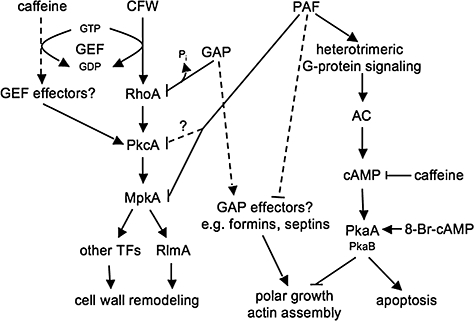Fig. 8.

Tentative model for the mode of action of the antifungal protein PAF in A. nidulans. PAF activates the cAMP/PkaA signalling cascade via heterotrimeric G-protein signalling (Leiter et al., 2005), which leads to apoptosis and to defective actin polymerization and apolar growth (this work and Leiter et al., 2005). Note that the secondary catalytic subunit PkaB could be involved in signal transmission of PAF and caffeine due to partly redundant functions in PkaA signalling in A. nidulans (Ni et al., 2005). Actin assembly and polar growth might also be disturbed via so far unidentified RhoA-GAP effectors. PAF further fails to activate MpkA and probably also PkcA (this work), disrupting basal resistance of A. nidulans towards antifungal activity. In contrast, the cell wall interfering drugs CFW and caffeine induce CWI signalling and cell wall remodelling in a RhoA-dependent and RhoA-independent way respectively (this work and Kuranda et al., 2006; Fujioka et al., 2007). The cell wall remodelling by MpkA-independent pathways, as documented for A. nidulans (Fujioka et al., 2007), were not considered in this diagram. Dotted lines and question marks represent so far unidentified connections. AC, adenylate cyclase; CFW, Calcofluor white; GAP, GTPase activation protein; GEF, guanine nucleotide exchange factor; PAF, Penicillium chrysogenum antifungal protein; TFs, transcription factors.
